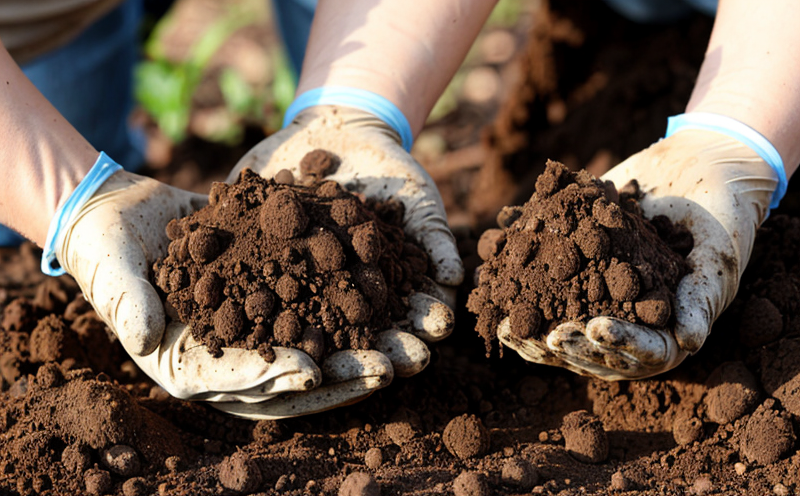ISO 17627 Soil Cellulase Activity Testing
The ISO 17627 standard provides a robust framework for determining cellulase activity in soil samples. This testing procedure is essential for understanding the role of microorganisms that degrade complex carbohydrates such as cellulose, which are critical components of organic matter decomposition and nutrient cycling.
Cellulases play a pivotal role in the breakdown of plant cell walls, contributing to the overall health of ecosystems by facilitating the release of sugars. This activity is particularly important for assessing soil fertility and the efficiency of microbial communities involved in biodegradation processes. The ISO 17627 protocol ensures accurate quantification of these activities under controlled conditions, allowing for reliable comparisons between different samples.
The testing process involves several key steps: sampling, preparation, inoculation with defined microorganisms, incubation, and measurement using spectrophotometric methods. Each step is meticulously detailed in the ISO standard to minimize variability and ensure consistent results across laboratories. This protocol allows researchers and industry professionals to assess not only the raw biomass but also the functional potential of microbial communities.
The importance of this testing cannot be overstated for various sectors, including agriculture, environmental science, waste management, and biotechnology. In agricultural applications, understanding cellulase activity helps in optimizing crop yields by enhancing nutrient availability through improved soil biology. For environmental scientists, it provides insights into ecosystem health and resilience against disturbances such as pollution or climate change.
The procedure’s precision is enhanced by its reliance on standardized methods that align with international standards like ISO 17627-1 for the extraction of cellulase activity and ISO 17627-2 for measurement. Compliance with these guidelines ensures confidence in data generated, which can be used to inform policy decisions at both local and global scales.
Given the complexity of natural systems, accurate assessment through ISO 17627 testing is crucial. It enables stakeholders to make informed choices about land use practices, pollution control measures, and sustainable resource management strategies. Furthermore, the ability to quantify cellulase activity provides a clear metric for evaluating the effectiveness of bioremediation projects aimed at cleaning up contaminated sites.
Understanding these activities also supports innovations in biotechnology where enzymes derived from soil microbes are used to develop novel products or processes. By leveraging this knowledge, industries can innovate more efficiently while ensuring environmental sustainability.
Quality and Reliability Assurance
- Standard Operating Procedures (SOPs): Rigorous adherence to ISO 17627 ensures consistent methodology across all tests.
- Calibration: Regular calibration of instruments used in the testing process guarantees accurate measurements.
- Data Validation: Independent validation by multiple reviewers enhances credibility and accuracy.
- Control Samples: Use of control samples helps monitor test consistency and reliability.
The quality assurance measures implemented are crucial for maintaining high standards in soil microbial research. By following these protocols, laboratories can ensure that their results are reliable and reproducible, thereby supporting robust scientific conclusions and informed decision-making.
Customer Impact and Satisfaction
The implementation of ISO 17627 Soil Cellulase Activity Testing significantly impacts various stakeholders within the agricultural, environmental, and biotechnological sectors. For quality managers and compliance officers, this service provides a critical tool for ensuring regulatory adherence and enhancing product safety.
For R&D engineers, it offers valuable insights into microbial interactions that could lead to breakthroughs in developing new biopesticides or biofuels. Procurement teams benefit from knowing they are sourcing materials with well-characterized microbial activities, which is essential for maintaining consistent performance across supply chains.
The results obtained from this testing can also contribute positively towards sustainability goals by guiding practices that promote soil health and biodiversity. This not only supports environmental conservation efforts but also contributes to economic stability through improved productivity and reduced costs associated with unsustainable practices.
Customer satisfaction is high among those who rely on accurate assessments of cellulase activity, as the service delivers precise and reliable data essential for making informed decisions. The confidence provided by these tests fosters trust between clients and service providers, leading to long-term partnerships built on mutual respect and shared objectives.
Use Cases and Application Examples
| Application | Description |
|---|---|
| Agricultural Research | Evaluating the impact of different land management practices on soil microbial activity. |
| Environmental Monitoring | Determining changes in cellulase activity due to pollution or climate change effects. |
| Waste Management | Assessing the effectiveness of biodegradation processes for waste disposal. |
| Biotechnology Development | Identifying potential enzymes for industrial applications through functional analysis. |
| Educational Institutions | Instructing students on fundamental microbial ecology and soil biology principles. |
| Regulatory Compliance | Ensuring compliance with environmental regulations regarding soil health. |
| Sustainable Development Projects | Monitoring progress in initiatives aimed at enhancing ecosystem resilience. |
The diverse range of applications highlights the versatility and importance of ISO 17627 Soil Cellulase Activity Testing. These examples underscore its relevance across multiple disciplines, making it a cornerstone for research, development, and compliance activities in these fields.





